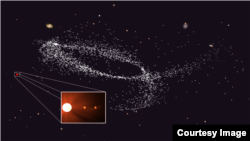An international team of scientists has discovered two new planets orbiting a star nearly as old as the universe, and one of those planets could have the conditions to support life.
Astronomers focused on Kapteyn’s star, the second fastest moving star in the sky and among the brightest and closest, just 13 light-years away.
That makes it an ideal candidate for study, says team leader Guillem Anglada of Queen Mary University of London's School of Physics and Astronomy.
“We can get higher precision on the measurements,” he said.
The astronomers recorded periodic changes in the motion of the star using spectrometers to calculate shifts in the star’s light.
“And this tells us that there is a planet around them,” Anglada said. Guillem Anglada-Escude, of the University of London, describes how new planets formed around Kapteyn's star, one of the oldest in the universe.
Anglada describes the two new planets in Monthly Notices of the Royal Astronomical Society. One planet circles Kapteyn's star in 48 days, the other in 120.
“And the one that goes around the star every 48 days, this is at the right distance from the star to allow liquid water on its surface," he said. "This is why we say it is potentially habitable.”
The planet, dubbed Kapteyn b, is about five times the size of Earth. The second planet, Kapteyn c, is a more massive super Earth that astronomers think is too cold to support liquid water. While the findings confirm the growing evidence that planets surround every star, Anglada says what sets Kapteyn's star apart is its age.
“It formed only 1 billion years after the universe was born. The universe has 13 billion years, around that," he said. "This means that the elements to form planets that could support liquid water were present very, very early in the story of the universe."
Anglada says life would have had a very long time to evolve, making Kapteyn b the oldest potentially habitable planet discovered to date.
The next step, he says, is to probe its atmosphere to find out whether it has water. Scientists are developing instruments to do that.
While we’re waiting for answers, you can see Kapteyn’s star in the sky over the southern hemisphere with a pair of binoculars.
Astronomers focused on Kapteyn’s star, the second fastest moving star in the sky and among the brightest and closest, just 13 light-years away.
That makes it an ideal candidate for study, says team leader Guillem Anglada of Queen Mary University of London's School of Physics and Astronomy.
“We can get higher precision on the measurements,” he said.
The astronomers recorded periodic changes in the motion of the star using spectrometers to calculate shifts in the star’s light.
“And this tells us that there is a planet around them,” Anglada said. Guillem Anglada-Escude, of the University of London, describes how new planets formed around Kapteyn's star, one of the oldest in the universe.
Anglada describes the two new planets in Monthly Notices of the Royal Astronomical Society. One planet circles Kapteyn's star in 48 days, the other in 120.
“And the one that goes around the star every 48 days, this is at the right distance from the star to allow liquid water on its surface," he said. "This is why we say it is potentially habitable.”
The planet, dubbed Kapteyn b, is about five times the size of Earth. The second planet, Kapteyn c, is a more massive super Earth that astronomers think is too cold to support liquid water. While the findings confirm the growing evidence that planets surround every star, Anglada says what sets Kapteyn's star apart is its age.
“It formed only 1 billion years after the universe was born. The universe has 13 billion years, around that," he said. "This means that the elements to form planets that could support liquid water were present very, very early in the story of the universe."
Anglada says life would have had a very long time to evolve, making Kapteyn b the oldest potentially habitable planet discovered to date.
The next step, he says, is to probe its atmosphere to find out whether it has water. Scientists are developing instruments to do that.
While we’re waiting for answers, you can see Kapteyn’s star in the sky over the southern hemisphere with a pair of binoculars.
